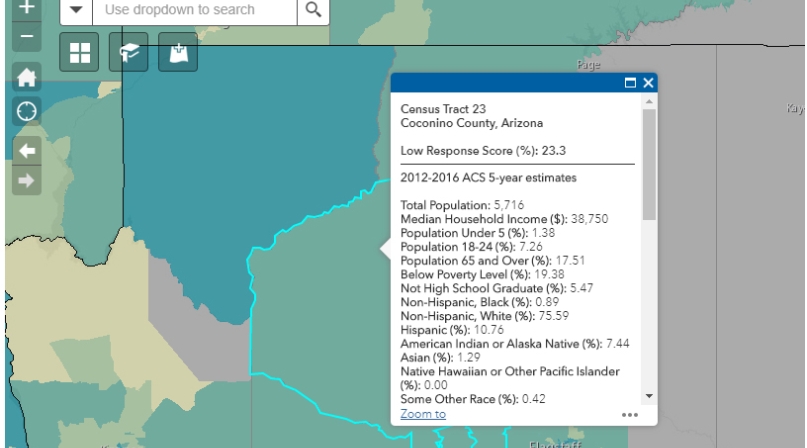Local efforts key to census accuracy

Key Takeaways
The 2020 census is still a year and a half away. But on the other hand, the 2020 census is only a year and a half away.
In addition to record keeping and congressional representation, the share of $800 billion in federal funding hinges on results of the census, making it crucial for counties to help ensure an accurate tally.
Although the Census Bureau will hire 500,000 temporary workers to follow up with addresses that do not respond, counties are in the best position to reach out locally to convince residents to buy in.
Learn More
View the predicted mail non-response rate for census tracts using the Response Outreach Area Mapper
“If you get the count wrong, your county is going to feel the impact for a whole decade,” said Karen Narasaki, a consultant to the Bauman Foundation. “Every statistic is normalized back to the census — food assistance, low-income heating, children’s health insurance, housing.”
The last two census counts have had 74 percent national response rates, and the bureau expects 65 percent of people to respond to census forms before the bureau initiates follow-up contact.
Counties typically form Complete Count Committees, which pair local officials with members of community groups and business owners to plan outreach.
Tim Olson, associate director of field operations for the Census Bureau, said counties should start forming committees in late 2018 and early 2019, but some have a head start. Coconino County, Ariz. has been planning throughout 2018 and along with its seat, Flagstaff, has pledged $300,000 over two years to aid outreach and turnout. That will make up for the loss of Recovery Act funding for the 2010 census.
“It’s less than $2 per resident,” said Kim Musselman, special assistant to the county manager and the coordinator for the county’s census work. “We estimate every person counted in the 2010 census accounted for $1,900 in federal funding, so it’s a pretty good return on investment.”
The county and city are splitting the contributions evenly, matching the population divide between the two. Both have significant challenges to overcome in the process.
Flagstaff has seen its population grow but also struggle with affordable housing, and Northern Arizona University carries more than 31,000 students.
“That means a lot of reaching out to renters, but that’s tricky,” said Musselman.
“With the price of housing, you may have six people staying in an apartment but four people on the lease. We have to communicate to them to answer the form truthfully and honestly. It’s confidential — they won’t get in trouble.”
The university has grown significantly over the last 20 years, and the 2000 census undercounted them.
“The problem there is convincing students to answer — they may have permanent homes elsewhere but as of April 1, they count for Coconino County,” Musselman said. “They’re using our infrastructure, our resources for nine months of the year.”
Outside of Flagstaff is a different story. Coconino is the second largest county by area in the contiguous United States, with small pockets of population throughout a vast landscape, including the most remote community in the lower 48 states, accessible only by foot, mule or helicopter. Lack of broadband connectivity there and in other counties will prevent many residents from answering online.
In addition to the practical considerations, trust in the process will also be a challenge, particularly demographic groups, many of which are historically undercounted, particularly African Americans, Hispanics, Asians, Native Americans, children under the age of 5 and the poor.
“One quarter of Asian immigrants have never experienced a census,” Narasaki said. “We’ve never had a solid answer on why it’s hard to get people to respond about children younger than 5.”
Wake County, N.C. plans to reach out to those demographic groups with a variety of community events, parades and municipal meetings. The county has staffed subcommittees for outreach and is ready to start in 2019.
“We will focus on events like the Raleigh International Festival and the Chinese language schools,” said Sharon Peterson, the county’s long-range planning administrator. “We meet with community leaders, particularly in the Hispanic, Asian and African American communities and work with them to carry the message to their members that it’s important to be counted.”
Like Coconino County, Wake County splits the effort. In 2010 municipalities contributed $25,000, and the county will contribute staff time to the outreach efforts.
A shadow hangs over preparations in the form of the citizenship question, which could suppress responses.
“It’s going to make it difficult for the federal government to say ‘give us your data and please trust us,’” Narasaki said. “In this environment where people are afraid, where they’re being picked up in courthouses and parks, schools and libraries, people are afraid to open their door and answer questions.”
The Census Bureau says that responses are confidential and don’t leave the bureau, but believing that, and convincing residents of that, is a challenge.
“We’ve talked a lot about mistrust of the government,” Musselman said.
“We haven’t figured out exactly how to remedy that, but our general message is that by not participating and not being counted, you’re playing into the very thing that they want, to minimize our population. Let’s stand up and be counted so that we are giving them what they are trying to discourage us from doing.”
Attachments
Related News

Pa. counties consider furloughs, loans as state budget lapse continues
For the third time since 2015, an unresolved state budget dispute that has dragged on for several months has left counties without the revenue that they depend on to provide critical services.

County library cooks up interest with chef series
Orange County, Calif.'s library system drew in new patrons by introducing its offerings through a cooking video series.

County repurposes airport’s lost and found items for animal shelter
Broward County, Fla. staff made use out of items left behind at the county airport.
